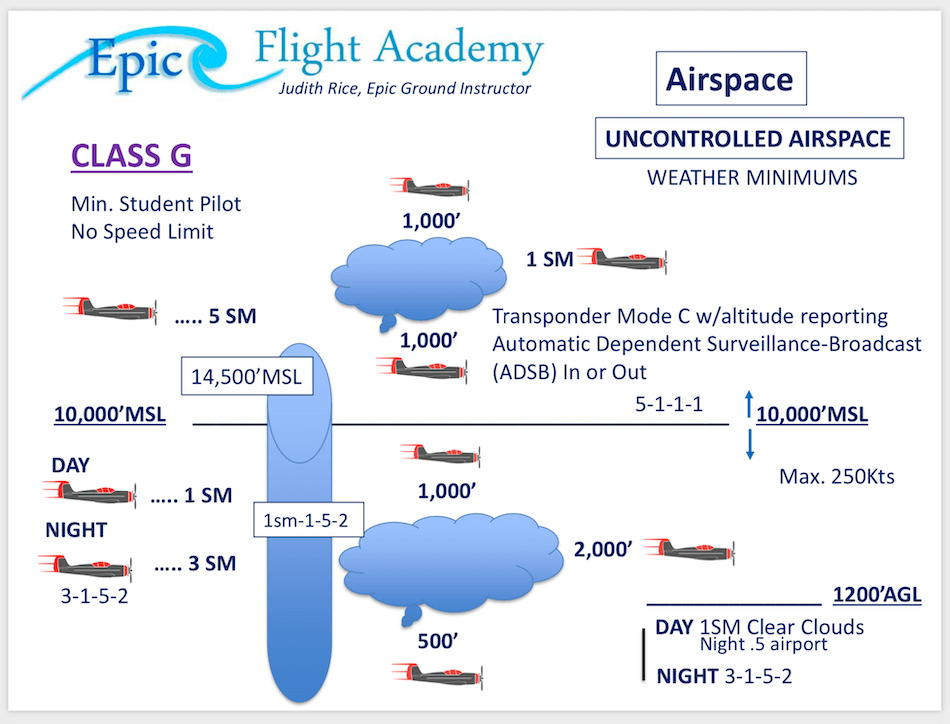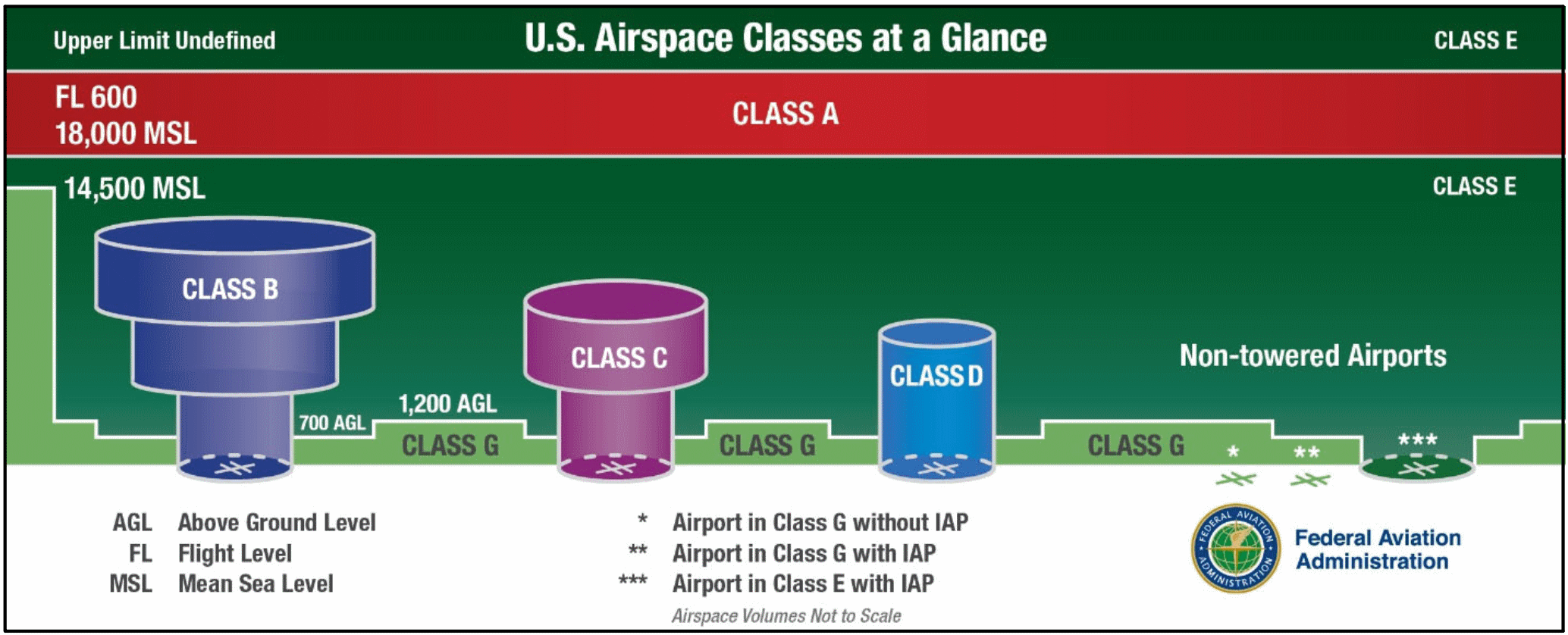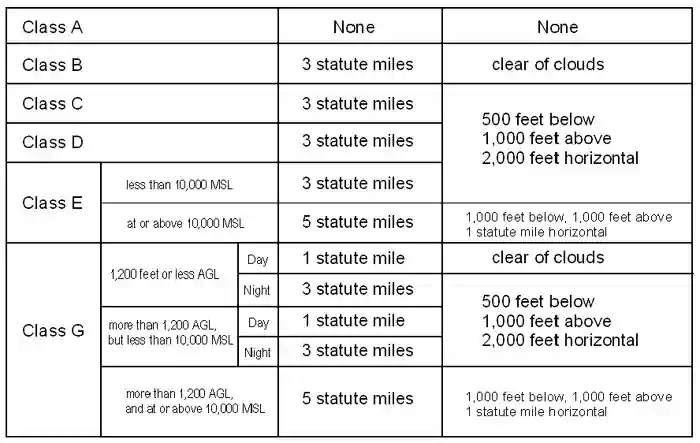class g airspace visibility requirements
1 SM vis COC - Night. Although Class G is uncontrolled it is also subject to the most weather restrictions based on where the airspace is located.
Regulations Vfr Minimums Learn To Fly Blog Asa Aviation Supplies Academics Inc
That airspace extending upward from 700 feet above the surface within an area bounded by a line beginning at lat.

. Airspace Requirements for Weather Minimums Communications You Can Fly. Class G During the Daytime During the daytime Class G weather minimums are still the same if at or above 10000 feet MSL five F-111s. Class A A for high Altitude or class alpha airspace exists from 18000 feet MSL up to 60000 feet MSL.
Class G Airspace Weather Visibility Requirements. 1 1200 feet AGL and lower 2 Above 1200 feet AGL but lower than 10000 feet MSL 3 10000 feet MSL or higher. Class G Airspace Cloud Clearance Visibility Requirements.
Visibility and cloud clearance requirements are less as well like in class G airspace. 1 statute mile visibility and clear of clouds. Keyboard Navigation Profile Motor-Impaired.
Minimum flight visibility and distance from clouds required for VFR flight are contained in 14. A helicopter may be operated clear of clouds in an airport traffic pattern within 12 mile of the runway or helipad of intended landing if the flight visibility is not less than 12 statute mile. Class G airspace uncontrolled is that portion of airspace that has not been designated as Class A Class B Class C Class D or Class E airspace.
Above 10000ft MSL the requirements are 5 SM visibility and cloud clearance of 1000ft above 1000ft below and 1 SM horizontally. Only 1 statute mile is required instead of three. 10 rows Airspace Flight Visibility Cloud Clearance 10000 MSL E 5 statute miles 111 41000 below 41000.
Youll also need to stay 1SM horizontally from 1000 above and 1000 below clouds. Your Path to Become a Pilot. If youre flying in Class E or G airspace your visibility requirement above 10000 MSL is 5SM day or night.
Around airports can drop to 700ft and even the surface. At night in Class G between 1200 AGL and 10000ft MSL the visibility and cloud clearance are the same as Class CD. Only IFR aircraft are permitted in class A airspace and air traffic control is responsible for ensuring their separation both vertically and horizontally.
3 SM vis 500 below 1000 above 2000 horizontal. Way out in the rural unpopulated areas the ceiling goes up to 14500ft. A Unless otherwise specified in the certificate holders operations specifications when conducting VFR helicopter air ambulance operations in Class G airspace the weather minimums in.
1200ft or less above the surface regardless of MSL altitude Day. Two-way Radio Communications Failure Instrument Flying Handbook 1-2 Airspace Classification. This beginning pilots resource guide explains what you can expect from your introductory flight through initial trainingand how to turn your dream of flying into reality.
August 16 2018 by ETL During the day less than 1200 AGL in class G airspace the flight visibility requirements are ½ statue mile and the cloud clearance requirements are to remain clear of clouds. Users can also use shortcuts such as M menus H headings F forms B buttons and G graphics to jump to specific elements. A Unless otherwise specified in the certificate holders operations specifications when conducting VFR helicopter air ambulance operations in Class G airspace the weather minimums in the following table apply.
2 Airplane powered parachute or weight-shift-control aircraft. 14 rows These minimums cover most Class G airspace but are only valid during the daytime when you are. 1200 feet or less above the surface regardless of MSL altitude 1 statute mile.
VFR weather minimums are there for your safety and the safety of every other pilot and passenger flying. Except as provided in 14 CFR Section 91157 Special VFR Weather Minimums no person may operate an aircraft beneath the ceiling under VFR within the lateral boundaries of controlled airspace designated to the surface for an airport when the ceiling is less than 1000 feet. Student pilots must comply with 14 CFR Section 6189 a 6 and 7.
36 rows Notwithstanding the provisions of paragraph a of this section the following. Class A Airspace Boundaries - FL180 18000 ft MSL up to and including FL600. ECFR Content 135609 VFR ceiling and visibility requirements for Class G airspace.
Daytime requirements for Class G are 1 statute mile visibility and clear of clouds to 1200ft. None - Class A is all IFR. This profile enables motor-impaired persons to operate the website using the keyboard Tab ShiftTab and the Enter keys.
Weather Requirements Class G minimum weather requirements exist so that you can see and avoid other aircraft and stay out of the clouds. Federal Aviation Regulations 91126 Operating on or in the vicinity of an airport in Class G airspace Federal Aviation Regulations 91177 Minimum Altitudes For IFR Operations Federal Aviation Regulations 91185 IFR Operations. B A certificate holder may designate local flying areas in a manner acceptable to the Administrator that must.
Get instant access to Flight Trainings special issue titled You Can Fly. Lets break the minimums down into three major categories. On the other hand Class G airspace has four different sets of altitude-dependent minimums.
Below 10000 feet MSL however the weather minimums are more relaxed than the requirements of Class E airspace. Rules governing VFR flight have been adopted to assist the pilot in meeting the responsibility to see and avoid other aircraft. Related Article Class G Airspace Explained Special Use Airspace.
Above 1200ft stays at 1sm visibility but then for cloud clearance you must be 1000ft above 500ft below and 2000ft horizontal. Class A Airspace Cloud Clearance Visibility Requirements.

Faa Airspace For Vfr Flight Youtube

Why Are There Mandatory Cloud Clearance Requirements Boldmethod

This Is How Class G Airspace Works Boldmethod

Vfr Cloud Clearances Pilot Training For Ga

Class G E Vfr Visibility Requirements Cheat Sheet I Made R Flying

Visual Meteorological Conditions Wikiwand

Airspace Classes And Special Use Airspace Everything There Is To Know
How To Remember Vfr Weather Minimums Bobbie Lind
How To Remember Vfr Weather Minimums Bobbie Lind

Helicopter Instrument Procedures Part Three
How To Remember Vfr Weather Minimums Bobbie Lind

Ifr Vs Vfr In Aviation Understanding The Differences Pilot Institute




